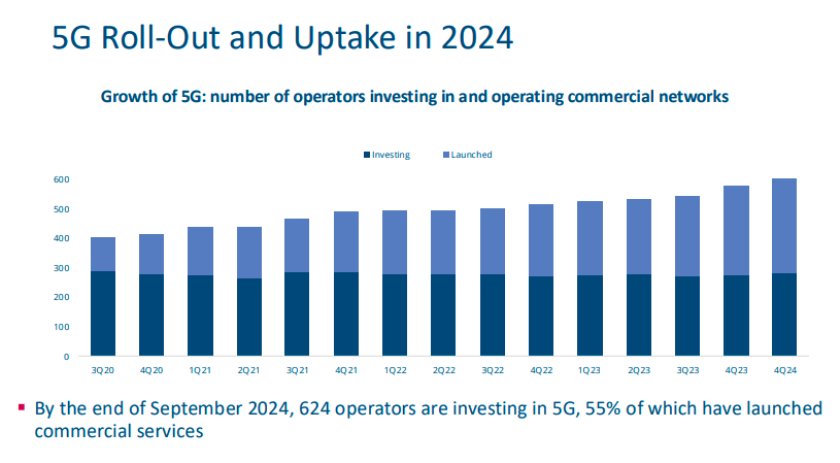The GSA 2024 review paints an optimistic picture of 5G’s global development, with impressive strides in network investment, device adoption, and innovative applications like private networks and standalone (SA) systems. However, a question arises: should the celebration of 5G’s progress be tempered by the fact that only 126 countries have launched commercial 5G services?

Progress in Context
Out of 195 countries globally, 126 adopting commercial 5G technology translates to nearly two-thirds. This is a significant achievement for a technology that began global deployment just a few years ago. Additionally, 58 more countries are in the investment phase, indicating that 5G is on the horizon for a substantial majority of the world.
5G Standalone (SA) Networks
151 operators in 63 countries are investing in 5G SA networks.
64 operators in 35 countries have launched 5G SA, with 30 more currently deploying and 57 planning future launches.
Pace of Adoption
The report highlights robust investments: 624 operators investing in 5G, with just 55 percent offering commercial services. The growth of 5G-enabled devices — rising by 54 percent in just a year — underscores the technology’s increasing reach. Such rapid adoption is rare for a technology of this scale and complexity.
Expanding Applications
5G’s impact goes beyond basic connectivity. The rise in private mobile networks, particularly in manufacturing, and the growing adoption of 5G-based fixed wireless access (FWA) services demonstrate its transformative potential in industries. This versatility is a reason to celebrate its advancement.
The cumulative number of LTE and 5G private network customers rose to 1,603 in 2024, up from 1,426 in 2023.
While LTE dominates with 1,172 deployments, 46 percent of customers are now integrating 5G, particularly in manufacturing.
321 manufacturing deployments (growing 8 percent quarterly) place this sector as the top adopter, with electrical equipment and appliances as leading sub-verticals.
5G Fixed Wireless Access (FWA)
201 operators are investing in 5G-based FWA services, and 169 operators have launched 3GPP-compliant services.
5G FWA accounts for 34 percent of fixed wireless services, up from 26 percent in 2023, with rapid growth anticipated.
FWA 5G shipments reached 10.2 million in 2023, an 18 percent increase from 2022, and are projected to grow by 53 percent to 15.6 million in 2024.

Challenges to Universal Adoption
Yes, 126 countries may seem limited when viewed against the backdrop of global inequality in technological readiness. Countries without 5G often face economic, infrastructural, or policy barriers that limit their participation. However, halting the celebration does little to address these disparities. Instead, the focus should be on fostering collaboration and investment to bring 5G to underserved regions.
Performance Metrics
5G availability, measuring the active connection time of 5G users, identified Puerto Rico, India, and Kuwait as top-performing regions. Seven of the top ten performers were from Asia.
Download Speeds: South Korea and Vietnam led globally, followed by Qatar, Brazil, and New Zealand.
Upload Speeds: Vietnam topped again, alongside South Korea, Guatemala, and Switzerland.
Setting Realistic Expectations
Technological rollouts, especially those as complex as 5G, take time. Comparing with previous generations like 4G, which took over a decade to achieve widespread global coverage, 5G’s current trajectory is nothing short of impressive.
Rather than halting the celebration of 5G’s remarkable advancements, we should view the progress as a stepping stone. GSA report highlights not just the accomplishments but also the opportunities for improvement. With ongoing efforts to bridge the digital divide, the remaining countries will likely join the 5G ecosystem sooner rather than later. The milestone of 126 countries is not a limitation but a testament to 5G’s rapid and far-reaching impact.
Baburajan Kizhakedath
